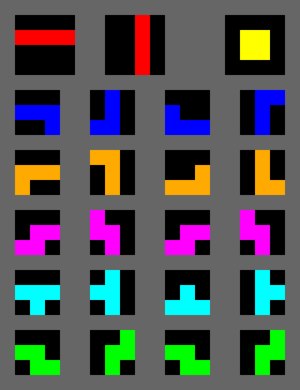Sega Rotation
Sega rotation is a rotation system that has been used by Sega's arcade version of Tetris and its successors.
Colors
Games using TGM/Sega rotation generally uses the following color scheme:
| I: red |
| |
| J: blue |
| |
| L: orange |
| |
| O: yellow |
| |
| S: magenta |
| |
| T: cyan |
| |
| Z: green |
|
Basic rotation

Tetrominoes start out centered, rounding to the left. I goes in columns 3–6 counting from the left, O in columns 4–5, and others in columns 4–6. Each tetromino starts with its topmost solid block in row 20 (or 22 in TGM ACE). Each tetromino is ordinarily spawned flat side up. However, if the player holds down a rotate button while the tetromino is being spawned, it is spawned rotated by one unit (Initial Rotation System).
Apart from I and O, all tetrominoes rotate such that the bottom of the tetromino is at the bottom of the piece's bounding box. S and Z rotate between two states so that the center column stays constant. O does not rotate; I rotates between two states as depicted in the illustration.
The differences between Sega rotation and Nintendo Rotation System are that the flat-side-down states of J, L, and T are pushed down by one space, that S and Z round in different directions, that I rounds differently from the other pieces, and that I requires more space under it to rotate to a vertical orientation.
Sega rotation originally used no wall kicks. Arika took Sega rotation, added mild wall kicks, and ended up with TGM rotation, or Arika Rotation System.